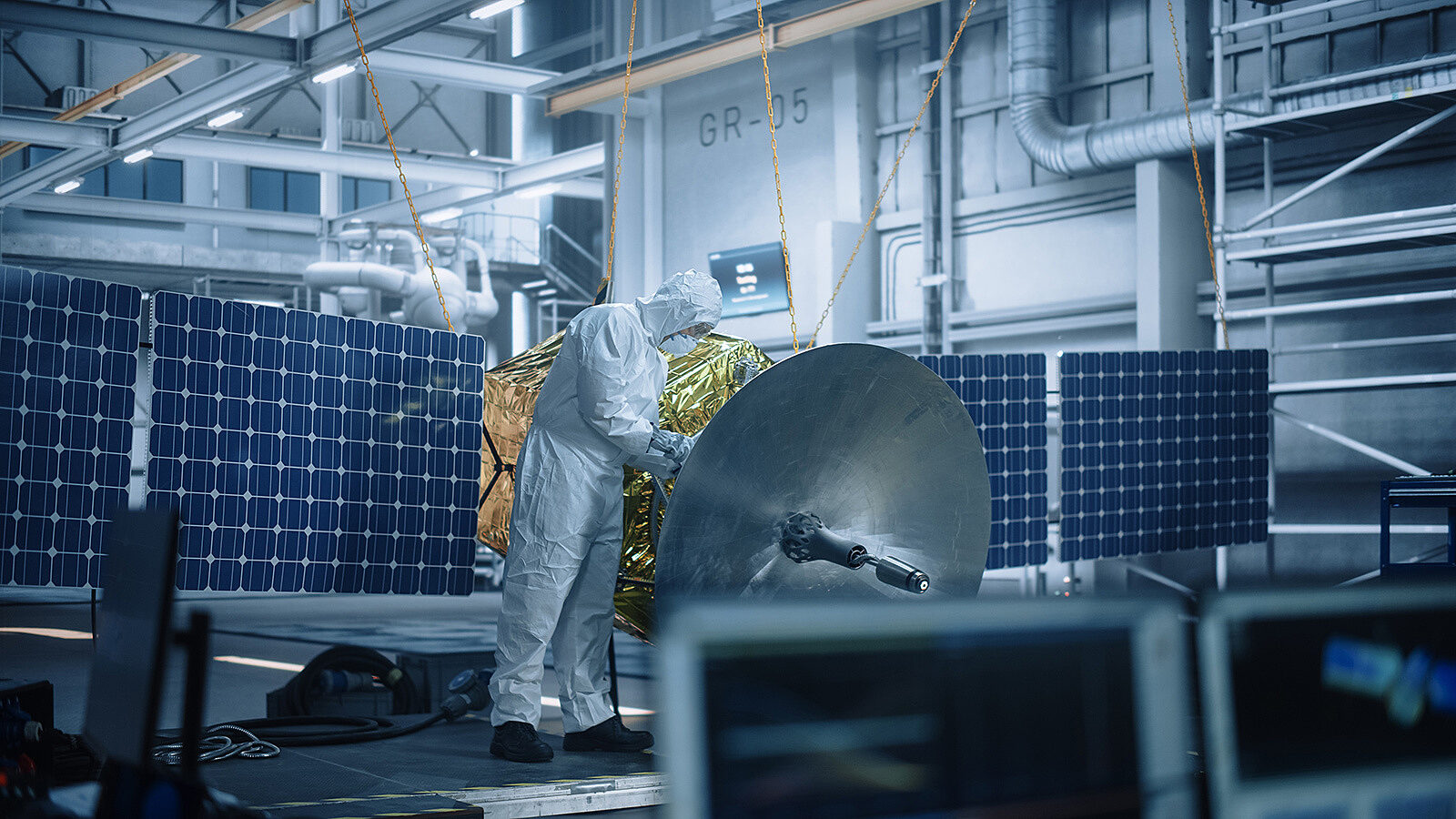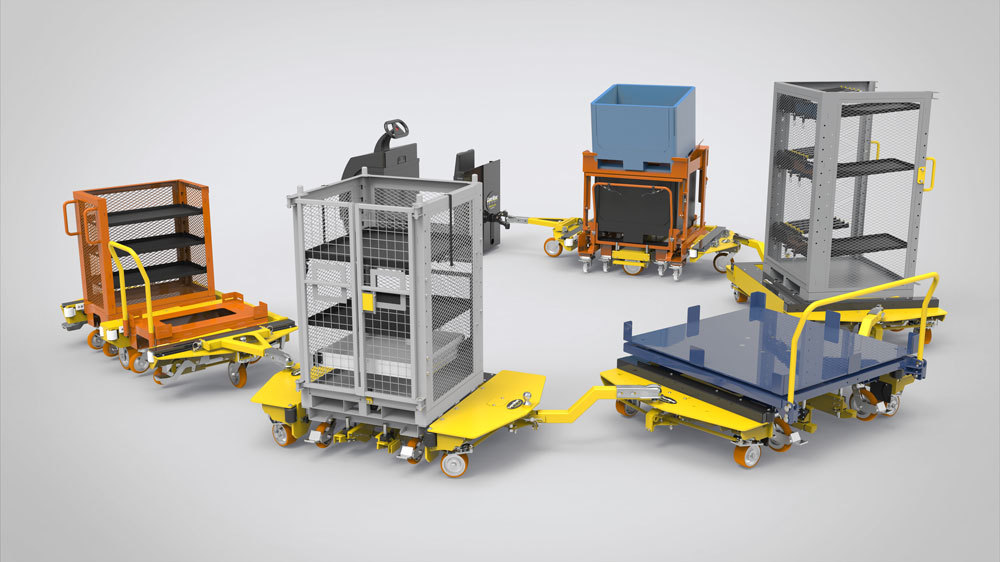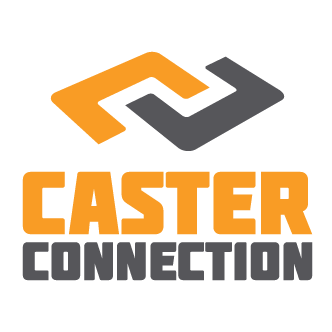Assessing Material Handling Needs in the Aerospace Industry

Material handling in the aerospace manufacturing industry is a complex and crucial component of production. Handling oversized components, fragile materials, and ensuring compliance with strict safety and precision standards demands careful planning and evaluation. Using the right casters on your carts, towlines, AGVs, or other material handling equipment can help you achieve stringent efficiency, quality, and safety standards present throughout your manufacturing process. In this blog, we’ll guide you through the essential steps to assess your material handling needs and optimize your systems for greater safety, efficiency, and cost-effectiveness.

Understanding Your Material Handling Challenges
Aerospace manufacturing involves the movement of a wide variety of materials, from heavy engine components to sensitive parts requiring precise handling. The industry's complexity means that material handling solutions need to be robust and flexible enough to accommodate the unique needs of an application.
Industry-Specific Needs
Aerospace manufacturers deal with large, often fragile, and expensive components. These materials require specialized handling systems to avoid damage and ensure the integrity of components. Additionally, there are strict compliance standards, such as AS9100, that must be met for safety and quality assurance.

Common Issues
Common challenges include dealing with heavy loads, awkwardly shaped parts, and fragile surfaces. Space constraints within facilities also play a significant role in determining how materials are moved. For example, tight aisles or limited overhead clearance may limit the type of caster setup that can be used. Moreover, aerospace manufacturers must also ensure compliance with rigorous quality standards, which can add another layer of complexity to material handling processes.

Evaluating Weight Capacity Requirements
One of the most important considerations when assessing material handling needs is evaluating the weight capacity of the casters, carts, and other equipment. Overloading equipment or using tools that can’t support the required loads can lead to safety hazards, equipment failure, and costly downtime.
The Importance of Load Assessment
For aerospace components, it’s crucial to assess the weight of typical parts and how they will be moved. Casters must be rated for the specific weight of the materials being moved, as well as potential dynamic forces if materials are being moved or positioned repeatedly.
Steps for Weight Evaluation

1. Inventory Typical Parts/Components
List the materials you'll handle most often and determine their average and maximum weight.

2. Calculate Average and Peak Load Weights
Consider the typical loads as well as peak weights that equipment might need to support.

3. Identify Load-Specific Risks
Overloading equipment or choosing the wrong casters can result in damage to the material and the caster itself. This is particularly important for sensitive aerospace parts, where material fatigue or damage could lead to costly failures.
To determine how much weight each caster must be able to support on your cart, towline, or other piece of equipment, use the following formula: Add the maximum cart load to its weight and divide it by the number of casters used for the application. Then, multiply it by the safety factor. If you are unfamiliar with the safety factor for your application, use this for reference:
- Indoor Manual Transport = 1.35 (under 3 mph)
- Outdoor Manual Transport = 1.8 (under 3 mph)
- Indoor Power-Driven Transport = 2 (under 3 mph)
- Outdoor Power-Driven Transport = 3 (under 3 mph)

Material Dimensions and Handling Complexity
The size and shape of aerospace materials significantly impact how they are handled. Casters must be selected not only based on weight capacity but also on the size and shape of the parts they are designed to move.
Size and Shape Considerations
Oversized and irregularly shaped aerospace components require customized material handling solutions. Casters with specialized wheel designs, such as those with larger diameters or specific tread patterns, may be necessary to accommodate large or heavy parts. For example, a donut wheel, like CC Apex, offers extra cushioning to help absorb shock and reduce noise, while a flat wheel holds more weight because there is less room for compression.

Dynamic Handling Needs
Certain components may require frequent repositioning, rotation, or delicate handling. For example, parts that need to be rotated into a specific orientation or moved carefully to prevent damage can benefit from casters with locking mechanisms or precision ball bearings that allow for smooth, controlled movement.
Additionally, combining rigid and swivel casters on a cart can provide an ideal balance between stability and maneuverability. Try fitting two rigid casters on the front of a cart and two swivels on the back to make it easier to turn, while maintaining ease of control. Be sure to experiment with the distribution of weight on the cart to find what works best for your application. For example, keeping most of the weight off of the swivel casters can help increase precision during turns.

Factoring in Facility Layout and Workflow
A key part of optimizing your material handling system is understanding your facility’s layout. Whether it's managing space constraints or improving workflow, ensuring that your system supports efficient movement is essential.
Space Constraints
Aerospace manufacturing environments often have tight aisles, narrow doorways, or limited overhead clearance. Casters can help optimize space utilization by allowing equipment to move easily through these tight spaces. Choosing casters with swivel capabilities and small turning radii can significantly improve mobility in these conditions. We also offer low-profile caster options to help reduce overall height.

Workflow Optimization
In aerospace manufacturing, time is of the essence. A material handling system that reduces bottlenecks and streamlines operations can greatly improve overall productivity. Casters that allow for easy maneuverability and controlled movement, like extended-lead casters, can help improve workflow, reducing time spent moving materials and minimizing the risk of accidents or damage.

Prioritizing Safety and Compliance
Safety and compliance are non-negotiable in aerospace manufacturing, and material handling systems must meet both regulatory requirements and operational safety standards.

Safety and Quality Standards
OSHA guidelines, as well as aerospace-specific safety considerations, should guide the selection of material handling systems. Casters play a key role here, as they must support safe and secure movement of materials, especially when dealing with heavy or unstable loads. Heavy-duty casters that properly distribute weight or those with locks can prevent equipment from tipping or rolling unexpectedly.
Maintaining material integrity during handling is a significant concern in aerospace manufacturing. Casters need to be designed to prevent any damage to sensitive parts, whether it’s preventing scratches on fragile surfaces or minimizing shock during movement.
Choosing the Right Material Handling Solutions
There are many types of material handling equipment to consider, and choosing the right casters is an important step in selecting the best solution for your needs.

Types of Material Handling Equipment
Options include cranes, hoists, conveyors, carts, forklifts, custom casters, automated guided vehicles (AGVs), and more. Each solution serves a different purpose depending on the types of materials being handled and the space available in the facility. Custom casters may be necessary for particularly heavy or fragile components.
Caster Considerations

Durability
Aerospace components are often subject to heavy usage, so casters must be durable enough to withstand the rigors of daily operations.

Flexibility
As aerospace manufacturing needs change over time, equipment should be adaptable. Casters that are easy to replace or upgrade can help extend the longevity of your material handling system.

Brakes and Locks
Casters with brakes ensure that materials remain stationary when necessary, such as during loading and unloading processes or when stabilizing materials for assembly.
Partnering With a Trusted Supplier
Choosing the right material handling solutions and casters for your aerospace manufacturing needs requires working with a supplier who understands the industry’s unique requirements. Suppliers with experience in the aerospace industry can help guide you through selecting the right casters for your needs, ensuring that your systems meet both operational and compliance standards.
Customization Options Through CC CHAT
Custom solutions are often necessary in aerospace manufacturing to accommodate unique component shapes, sizes, and handling needs. A trusted supplier can provide tailored caster options to meet these specialized requirements. Book a CC CHAT (Caster Health Assessment Tour) consultation for specialized guidance on implementing a material handling system tailored to your facility.

A Material Handling System That Will Help You Take Off
Optimizing your material handling systems is critical to improving efficiency, reducing risk, and ensuring compliance in aerospace manufacturing. By evaluating weight capacity, maneuverability, space constraints, and braking needs, manufacturers can choose the right equipment, including casters, to support smooth and safe operations. Don't hesitate to consult with an experienced supplier to help you make the best choice for your specific needs.
Ready to Launch?
At Caster Connection, we specialize in providing caster solutions designed to meet the unique needs of aerospace manufacturers. Our team can help you assess your material handling requirements and recommend the right equipment to improve efficiency, safety, and precision. Contact us today to learn more about how we can support your operations with high-quality casters and expert advice tailored to your needs.
